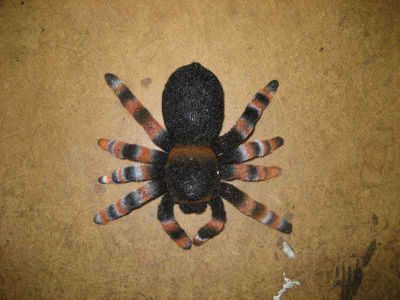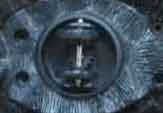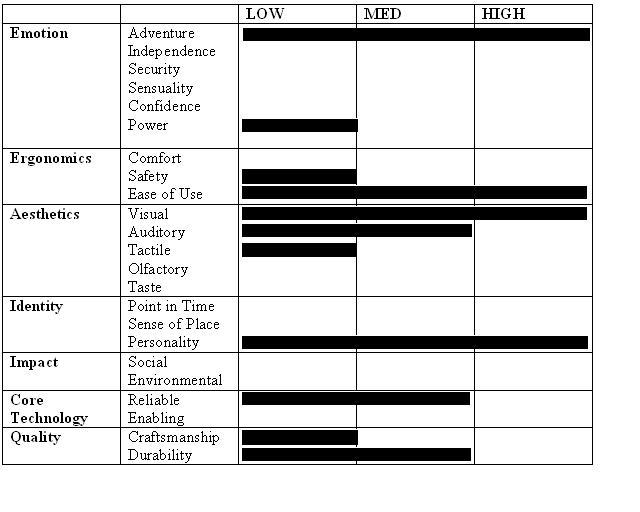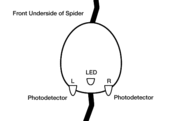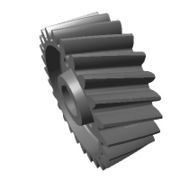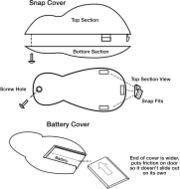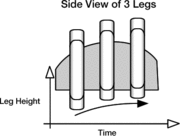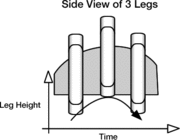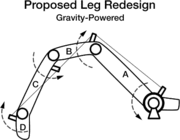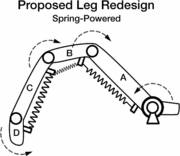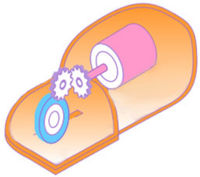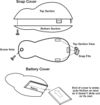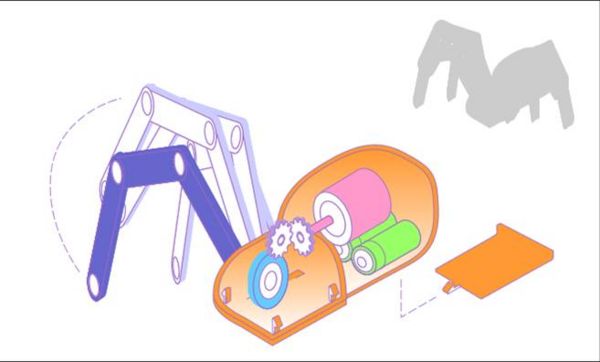Remote control tarantula redesign
From DDL Wiki
Contents |
Executive Summary
This report pertains mainly to the data and observations that allowed us to produce different design alternatives for the product. Through a comprehensive user study, a design analysis of the product function, and a Value Opportunity Analysis of the product, sufficient information was gathered to design new functionality for the product. The user studies provided interaction between the product and consumers. By gauging appeal and garnering suggestions from the target demographics, our group was able to better consider potential areas of further improvement in order to address user concerns.
The design analysis provided an understanding of the current status of the product. By gathering information regarding its function, we will be able to address user concerns in a proper manner. The current product has limitations in speed, traction, and turning. The mobility of the product is an important factor of its use, and the shortcomings and limited function in these areas is an important consideration for furthering the development of new design features.
The Value Opportunity Analysis (VOA) of the product provided useful information in understanding the experience and impact of the product on the consumer. By gauging the importance of these factors, we were enabled to produce innovations that would further accentuate these qualities of the product. The main focuses of the VOA that we considered were the ergonomics, aesthetics, and quality of the product. These particular qualities were addressed as the important factors of the experience that the user would get from interacting with the product.
The different design proposals involved improvements or innovations on established functions of the product. Five different designs were considered, each with certain benefits and costs to be addressed. These designs involved: improved agility, replacing the AAA batteries with AA, enhanced leg articulation, reduced noise, and autonomous motion. Each design took into account some limitation of the product, or improved upon the existing functions. All of these designs were put into a Design Decision matrix (Pugh Chart) in order to weigh the pros/cons that it would entail. By doing this analysis, the benefits of particular design considerations could be compared to that of other designs, allowing for a better understanding of what functions should be ultimately retained for the final concept.
The final concepts that our group recommend involve improvements on the existing product. Based on our analysis, we believe that these factors are important in improving the overall experience of the user, as well as the function of the product. The different design concepts that we recommend are: improved agility, replacing the AAA batteries with AA, enhanced leg articulation, and modification of the DFMA. By implementing these different suggestions, the overall realism of the product will increase, as well as its capabilities in use and production. The DMFA concerns will decrease the need for as many parts, and allow for simplification of production. Also, the increased voltage and energy provided by the different batteries will allow the product the increased mobility provided by modifying the agility parameters. By incorporating these separate design concepts, the final concept provides an improved and innovative modification of the existing product.
Report 1 Revisions
The first report can be found at: Remote control tarantula.
The comments and suggestions made regarding the first report have been accounted for in the redesigning of the report. Points that were brought up have been addressed, and have been improved upon considerably.
The report now includes a picture of the product, allowing for a better visualization and understanding of the product at the start. Secondly, the executive summary includes information and conclusions derived from the calculations and observations made in the analysis. It is now more comprehensive in the material that it discusses and allows the reader to gain a better grasp of the project through reading the summary.
The FMEA data has been supplemented with additional discussion of the findings. This will allow the reader to understand conclusions based on the data without requiring them to sift through all of the information. Additionally, the LCA incorporates a more comprehensive understanding of the economic and environmental costs due to the use of batteries. Battery consumption plays a larger role in the use of the product over its lifetime than was originally discussed, and the new analysis addresses this discovery
The report has undergone changes in the areas suggested in order to be more comprehensive and informative than in its previous iteration. We hope that it provides all of the necessary information required, and that the insights it presents will serve the customer well.
Research and Observations
User Studies
To further our research of the product, our analysis included a study of user interaction. Two of SW Randall toy store locations were chosen, one in downtown Pittsburgh, the other in Squirrel Hill. The first study was conducted during the lunch break of working adults, while the second was conducted on a weekend afternoon. These two studies allowed for access to the different demographics that would drive the demand for the product.
The first study introduced the product to adults, who would ultimately be the purchasers of the product. This was done to understand adult usage and interaction of the product. The second study was conducted to allow for a greater interaction of the product with younger children. By doing so around 5PM on a Saturday afternoon, there was a greater chance of interaction with families with young children. Users were asked to express any comments or suggestions regarding improvements or positive aspects of the product. These comments were taken into account when devising potential design changes of the product, as well as gaining a better understanding of what qualities were considered more important than others. By conducting this user study, the analysis of the product would be made more complete by accessing the needs of the customer during further development.
Two particular cases of product interaction with young child involved two young children. A female, age 4, found the product easy to use and liked the way it looked. If she was dissatisfied with the positioning of the tarantula, she would pick it up and rearrange it herself frequently. The second was a male, age 2, who would follow after the tarantula as he controlled it.
Comments ranged from positive to negative, touching upon aspects of both function and aesthetics. Some suggestions pertained to increasing the function of the tarantula. Specifically, increased manipulative controls were suggested. Having control of the mouth or the feelers was proposed, increasing the potential uses for the product. Other users commented on the need for increased aesthetic appeal. These suggestions pertained to the appearance of the product, either changing the color of the exterior, or increasing the amount of fur coverage to conceal any mechanical parts. Also, complaints about the amount of noise created were noted. Certain modifications were suggested, among them the ability to jump or to eject a projectile. Generally, the user response to the product was positive, taking into account the different limitations of the product.
The main points addressed to improve involved improving the overall experience of using the product. This could be done through increasing the realism of the device, either by modifying the articulation of the legs and the tarantula motion, or by creating a more realistic model of a tarantula body. Also, the function of the product could be increased with a greater range of control and function. Specifically, allowing the tarantula to turn in two directions was suggested by all users.
Design Analysis
Mobility
The Tarantula has several issues relating to mobility. This toy is essentially the unification of a realistic tarantula doll and a remote controlled car. Mobility is an essential component in differentiating this product as novel and enjoyable.
Traction
The most readily correctable mobility problem is poor traction on many surfaces. The wheels of the Tarantula are small and made of smooth plastic. This allows for consistent movement only on the smoothest of surfaces, and had issues moving on a relatively smooth cement sidewalk. Moving on asphalt would be even more difficult, and grass would be completely out of the question. This limits the toy to use indoors, and only on hardwood, tile or linoleum floors.
Speed
The Tarantula only moves forward at a single set speed. This speed was deemed unsatisfactory by most of the users polled. A significant source of enjoyment with this product is its ability to scare others. By moving at a slow pace, it is much more difficult to startle others and users are forced to hide the toy or place it unnoticed.
Turning
The toy can only turn in one direction, and only turn in place. The user is unable to turn the Tarantula while it is moving forward, and younger users often resorted to manually turning it. Also, the realism of the product is diminished, as it lacks the agility that a real spider would have. Lastly, it is possible to be blocked by an object on its right side and become stuck. Only able to turn clockwise, it is unable to orient itself away from the object and move away.
Articulation
The current leg articulation is insufficiently realistic. The legs actuate themselves in a predictable, smooth pattern, that is incongruous to real arachnid behavior. Each leg is stiff and simply raises up and down – there is no further joint motion. Therefore, both the overall pattern of movement between the 8 legs and the individual movement of each leg need to be improved.
Cost
The Tarantula normally retails for $19.99 at Target stores. An employee of SW Randall Toys described this as undervalued, and that at their store they would price it at at least $30. Further, with electronic toys price implies resources devoted to quality rather than advertising or licensing. At retailers which specialize in this type of toy, such as Radio Shack, most remote controlled cars are priced $30 - $60, partly due to this effect. We are confident that given this higher price range, we will be able to expand the functionality of the product while keeping it sufficiently affordable.
Battery Life
The current battery life of the tarantula left a lot to be desired in the user perspective. The robot went through batteries too quickly and it took away from the experience and from the user's wallet to have to replace batteries frequently. The battery power also limits the power of the tarantula as it is currently.
DFMA
Upon inspection of the tarantula up close, it became obvious that the shell of the robot used far too many fasteners and that there were a lot of unique parts within the interior. Nearly all of the parts were unique, in fact, except for two wheels and two gears.
Value Opportunity Analysis
After identifying the major opportunity areas above, our results are displayed visually. This chart was used in during the generation of concepts to focus on areas with most room for improvement.
Proposed Design Alternatives
Autonomous Motion
A potential modification to the product design that was considered involved enabling product with the capabilities for autonomous motion. This design would be able to address user needs for increased control of the product, as well as providing an alternative mode of interaction with the device. This change in the experience for the user would be positive in that it is an innovative method for remote control, increasing its appeal.
The control method of the product would involve some form of line following. This control scheme uses 2 photodetectors on the underside of the product that would respond to the changes in the amount of light reflected by the surface it travels on. A LED would provide the light, while the traveling surface would either reflect or absorb that emitted light. The photodetector would respond to the changes due to the presence or absence of light, and modify its traveling course accordingly.
Specifically, if sensor L (in accompanying diagram) detected a dark line against a bright surface, the tarantula would have traveled too far to the right, and would steer to the left. Consequently, a detection in sensor R would cause the tarantula to steer right. The goal would be to keep the dark line between the two sensors.
However, this design also introduces additional problems. The introduction of additional hardware would create added energy demands on the limited resources. The tarantula would require additional voltage or electrical energy, which would in turn lead to an increase in the amount of batteries required. This necessity would create the need for a larger battery slot, which would ultimately require a complete change in the design of the tarantula. In order to support the additional power and control requirements, the overall size of the product would be changed, which would present further problems in manufacturing and production that will not be discussed currently.
Also, the limitations of this design would not provide enough additional benefits to outweigh the costs. Increasing the power demands and the size of the product would introduce the need for a redesign of the power, motion, and control systems. This added cost would transfer to the consumer, which may not translate well due to the relatively minute additional features that it introduces.
Noise Reduction
To improve the realism and stealth of the toy, reducing the noise generated was proposed. The ability to startle people is a crucial aspect of the toy, and quiet movement helps accomplish this goal. This can be achieved in two primary ways. First, the motor can be run at a lower RPM. The transmission would be compensated so that the speed and rate of leg movement would be acceptable. Running electric motors below their optimal speed decreases the energy efficiency as well as total power output. A larger motor would compensate for this, but still total agility and battery life would suffer as a result of this modification. The second method of decreasing noise reduction would be to better seal the chassis and add sound dampening. This would complicate the manufacturing process by requiring a sealant to be added near the end of assembly. Also, effective sound dampening tends to be voluminous and difficult to fit into a small toy. This would pose an obstacle to increasing motor size, turning ability and battery size while still achieving a realistically sized toy. Finally, noise and vibration can be reduced by using helical gears rather than spur gears. The smooth meshing of helical gears eliminates the impact of two teeth initially meshing. However, the gears that currently exist within the product do not even have an involute profile, rather they have triangular teeth. To go from these low cost gears to high quality helical gears would likely be cost prohibitive.
Snap-tight Top and Bottom w/ Sliding Battery cover
When taking apart the tarantula there were some blatantly obvious design-for-manufacture improvements possible in the robot. We noticed that to take just the bottom shell off of the top shell took upwards of 11 screws. Furthermore, the battery cover on the bottom of the shell required a screwdriver to remove. It was proposed that a snap-tight shell be designed to reduce the number of screws in the product, reduce the overall weight of the product, and make it look more streamlined (no precut holes for screws, no off-color markings).
The snap-cover would consist of 3 prongs, situated on one side of the shell, with a single screw to fasten the two sides securely. Please refer to the picture for positioning. With this design, many fewer fasteners would be used, but the single screw would restrict the top from accidentally disconnecting from the bottom when the robot was dropped. The bottom section of the tarantula would have receiving channels for these snaps, and the two pieces would snap snugly together.
The battery cover was an obvious spot for improvement, mainly because of the amount of batteries we had to go through in testing the product. It just became a nuisance to remove and replace the cover, so much so that for some testing we just used the robot without any cover on the batteries at all. As a replacement, the battery cover would be a sliding door, as illustrated in this picture. The sliding door would effectively reduce the number of fasteners and parts on the tarantula.
Both of these modifications would also drop the weight, and therefore the energy usage, of the robot.
Replacing AAA with AA batteries
In looking at the design plans for the tarantula, and also by analyzing the suggestions of our test users, one concept was to increase the battery capacity of the robot, to lengthen its life between battery switches and/or allow for improvements without significant changes in the amount of time it would take to burn through a set of batteries.
The change would add weight, but also versatility, to our final design concept. It would increase the energy usage, but it would be required to implement some of our more power hungry ideas.
Leg Articulation
One of the most commented-upon areas of improvement of the spider is its realism. The mechanical component to this realism lies in the movement and articulation of the spider’s legs. Our goal is to make the motion appear much more natural to an arachnid. There are two areas to consider: the coordination of movement between legs, and the movement of each individual leg.
8-Leg Sequence
Regarding the coordination of movement, it’s important to compare against the existing design. Each of the spider’s 8 legs is essentially a rigid beam, attached to a fulcrum on the body, with an internal beam acting as a lever. Inside, a cam with a raised, elliptical profile rotates against each leg.
Gravity pulls on the outer part of the leg, causing it to rest against the profile of the cam. As the cam rotates, its profile causes each leg to raise and lower, in a smooth, fluid fashion. The resulting motion causes the legs to raise and lower in sequence, in a manner close to a sine wave.
While this would be aesthetically pleasing for a fish, snake, or bird, the dynamic, seemingly random, incredible complexity of movement of insect and arthropod legs generates the greatest reaction from human beings. Therefore, a more non-uniform leg motion, where adjacent legs seemingly move independently of each other, would be preferred. At the minimum, this can be accomplished by increasing the complexity of the cam profile. The cam profile doesn’t need any symmetry – asymmetry enhances the ‘mystery’ of the leg movement.
Individual Leg Motion
As mentioned previously, each leg is rigid. This detracts from the realism of a bioform – as mobile organisms, we possess multiple joints that move in relation to each other. To achieve this motion in our leg design, we first must segment each leg into repeatable, smaller links. We then rely the driving input of the cam, against the force of gravity on the outer part of the leg. We propose one of two methods of articulating the legs:
Gravity Powered
Each segment, A, B,C, and D is tethered together. As segment A rotates downward, the tension in its tether will pull on B, causing it to rotate upwards. This tether in turn pulls on segment C, causing it to rotate inward. Finally, the tether from C to D pulls D outward.
Spring Powered
Each segment, A, B, C, and D is attached together with small springs. As segment A rotates downward, the attached spring is compressed, which presses B outward. B’s motion compresses its spring, which presses C outward. In tension, C’s spring draws D inward.
Either implementation would preferably be integrated within the shell of each leg. Hiding the working mechanisms aids in the believability of the spider.
Improved Agility
As mentioned in the Design Analysis section, the issues with mobility are speed, turning and traction. A more powerful motor would be used to increase power and torque output. The transmission would then be geared to a lower ratio than it currently is, to produce greater speed. The higher torque output should allow for the changing of this ratio without compromising torque to the wheels. Variable speed would be implemented electronically, by changing voltage to the motor. Though this would reduce torque, the variable speed is designed only to improve realism and user control. To implement turning while moving, two sets of wheels would be used. Front turning wheels would be controlled by a separate, small servo motor. This would increase the complexity of the system, and potentially create space issues, but would greatly improve the functionality. To improve performance on different surfaces, larger wheels would be used. These wheels could also be given a rubber tread to improve grip and maximize motor output on smooth surfaces.
Design Decision Matrix
Using a Design Decision matrix, or a Pugh Chart, the team was able to identify the most worthwhile concepts. The chart evaluates the designs on a variety of factors relative to the original toy configuration. Weighting each factor appropriately and summing the resultant values give a quantitative measure of each design's utility.
Final Concepts
Improved Agility
Using the analysis done in the VOA and Pugh Chart, improving mobility is clearly worthwhile. While this may be the most ambitious of our concepts, it yields the greatest benefits. Increased user control extends the possibilities of use for the product. It also enhances the overall experience by being responsive to the user inputs and better mimicking the quick movements of a real spider.
DFMA
In short, the DFMA choices we made have no downside - we are reducing part count, item weight, and clutter. This is an easy fix that only requires injection-molding model modifications. The positives of this decision will aid in keeping energy usage down when implementing other, more ambitious plans.
Leg Articulation
Leg articulation is one of the most important elements in creating realism in the spider. The motion and appearance of a spider is visually defined by its legs. The motion of the legs themselves create the illusion that they are driving the spider’s path of travel. Without legs, our product becomes a remote controlled car. Without moving legs, we have created a spider that magically ‘floats’ across the ground.
The cam improvement is highly recommended. It is simply a modification to a shape of an existing part – no additional materials are required. The part is slightly more complex, but its complexity is trivial considering the available plastic manufacturing processes used to achieve it.
The leg articulation is strongly recommended, but it greatly increases the manufacturing complexity of the product. However, the leg segments can be designed such that they are redundant, allowing for each of the different legs to be composed of different combinations of recurring leg parts. And, considering one of the main fears people have of spiders as being “creepy and crawly,” it is imperative that the actual creeping and crawling appearance be improved.
Semester Plan
Gantt Chart
The chart below describes the the work plan for the semester, based on different aspects of the prototyping process.
Project Roles
Roles during the Semester:
Jehan Azad - Mechanical and Functional Analysis
Chris Sullivan - Manufacturing and Assembly Analysis
Jordan DeVries - Mechanical and Functional Design
Timothy Cheung - Environmental and Life Cycle Analysis
Original Proposal
Proposal can be found at: Remote control tarantula.
